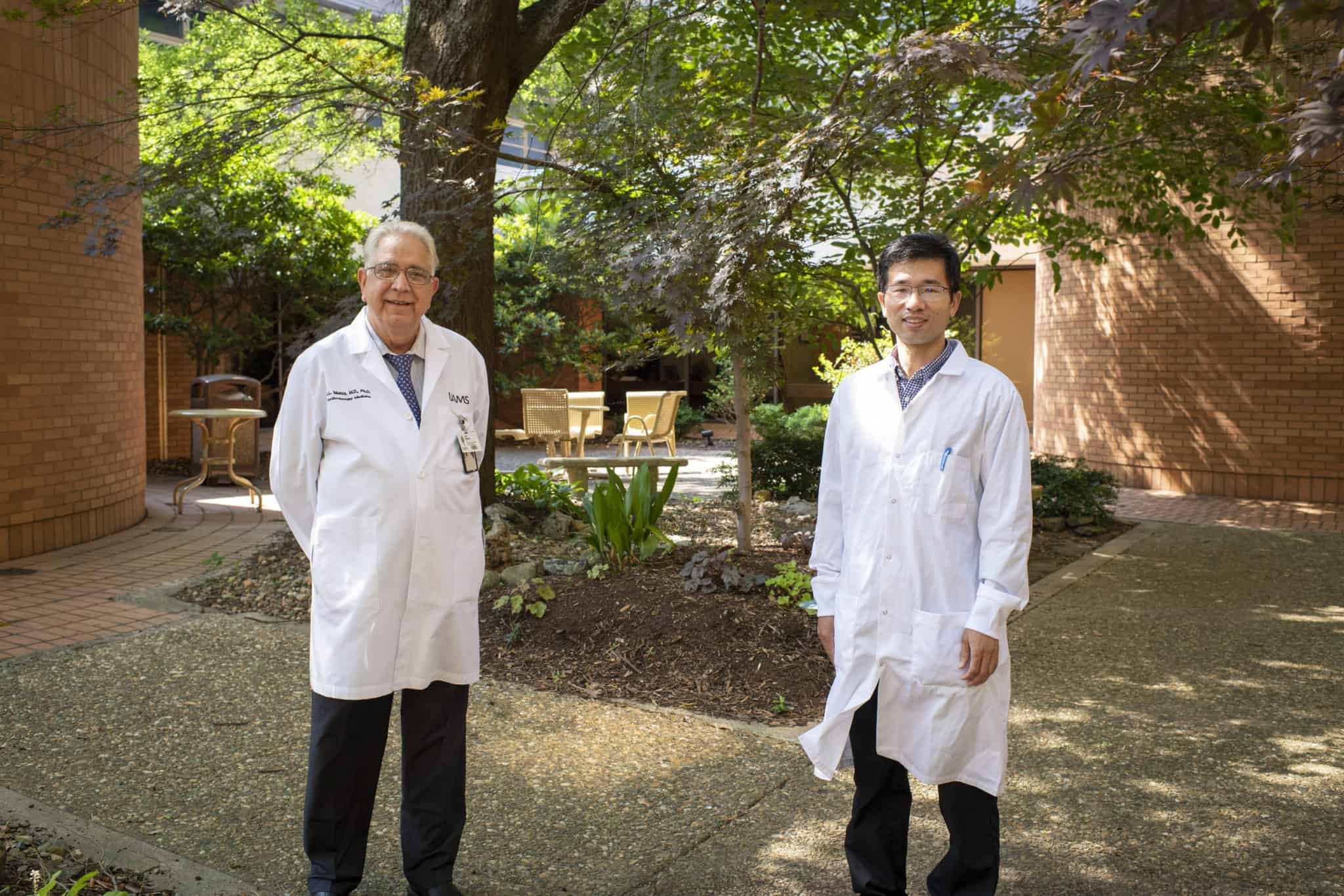View Larger Image

Zufeng Ding, Ph.D., and J.L. Mehta, M.D., Ph.D., of the Division of Cardiovascular Medicine, have published new findings on the connections between inflammation and heart disease.
Image by Bryan Clifton
Research Finds Inflammatory Connection for High Cholesterol, Suggests Possible Combo of Medications
| New research at the University of Arkansas for Medical Sciences (UAMS) and the affiliated VA Medical Center suggests a combination of drug therapies – one that already exists and a second that would need to be developed to target a specific inflammatory response – could be effective for managing high LDL-cholesterol and atherosclerosis, and the associated deadly conditions.
Zufeng Ding, Ph.D., an assistant professor in the Division of Cardiovascular Medicine in the Department of Internal Medicine in the UAMS College of Medicine, has been studying atherosclerosis along with J.L. Mehta, M.D., Ph.D., distinguished professor in Internal Medicine and Physiology and Biophysics, for more than 10 years.
Both are world-recognized experts in the field, and several key advances have emerged from the division’s synergistic and active research environment.
Ding’s publication “NLRP3 inflammasome via IL-1β regulates PCSK9 secretion” in the journal Theranostics, is the latest from UAMS to expand the scientific knowledge base on exactly how high cholesterol works at a cellular and molecular level, which gives scientists ideas on which biological processes to target to develop effective drug therapies.
Atherosclerosis refers to the hardening of the arteries because of the build-up of fats and cholesterol. It is the basic cause behind a number of life-threatening illnesses such as heart attacks, strokes, heart failure and high blood pressure. These diseases are the leading killers in the West and are of growing concern elsewhere in the world.
In this study, Ding showed that when cells called macrophages from the arteries are treated with NLRP3, a string of proteins involved in the body’s inflammatory responses, the macrophages create and release large amounts of another substance called PCSK9. PCSK9 is a protein associated with the amount of LDL-cholesterol in the body. LDL, or low-density lipoprotein, is often called the “bad” cholesterol, because it is the one that tends to collect in the arteries and clogs them.
“There is growing evidence in the field that there is an inflammatory – or immune system – response that plays a role in the development of atherosclerosis and heart disease,” Ding said. “Our study adds to that body of research, specifically by suggesting that there is a connection between inflammation and the presence of bad cholesterol in the body through this relationship we illustrated between NLRP3 and PCSK9.”
To further explore this connection and test the theory, the publication included a second study in which mice were fed a high cholesterol diet. The diet caused them to generate large amounts of PCSK9, the protein involved in increase on LDL-cholesterol. The researchers then used known methods of blocking NLRP3, the inflammatory response, in these mice. This caused a significant decrease in the amount of PCSK9 released in their systems.
“Through a combination of these two methods, we showed a definitive link between inflammation and PCSK9 and how we might control cholesterol levels and atherosclerosis by controlling inflammation,” Ding said.
The study suggests a potential role of a combination of drug therapies for atherosclerosis. Drugs that reduce PCSK9 already exist, but inflammatory drugs that target NLRP3 would need to be developed.
“We suggest in this paper that possibly a combination of the two should be used concurrently,” Ding said.
Funding for the research came from the U.S. Department of Veterans Affairs, the American Heart Association and the National Institutes of Health.
UAMS is the state’s only health sciences university, with colleges of Medicine, Nursing, Pharmacy, Health Professions and Public Health; a graduate school; a hospital; a main campus in Little Rock; a Northwest Arkansas regional campus in Fayetteville; a statewide network of regional campuses; and eight institutes: the Winthrop P. Rockefeller Cancer Institute, Jackson T. Stephens Spine & Neurosciences Institute, Harvey & Bernice Jones Eye Institute, Psychiatric Research Institute, Donald W. Reynolds Institute on Aging, Translational Research Institute, Institute for Digital Health & Innovation and the Institute for Community Health Innovation. UAMS includes UAMS Health, a statewide health system that encompasses all of UAMS’ clinical enterprise. UAMS is the only adult Level 1 trauma center in the state. UAMS has 3,485 students, 915 medical residents and fellows, and seven dental residents. It is the state’s largest public employer with more than 11,000 employees, including 1,200 physicians who provide care to patients at UAMS, its regional campuses, Arkansas Children’s, the VA Medical Center and Baptist Health. Visit www.uams.edu or uamshealth.com. Find us on Facebook, X (formerly Twitter), YouTube or Instagram.###